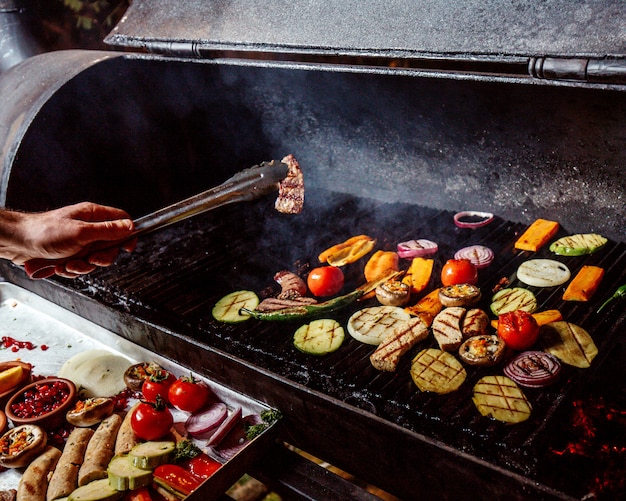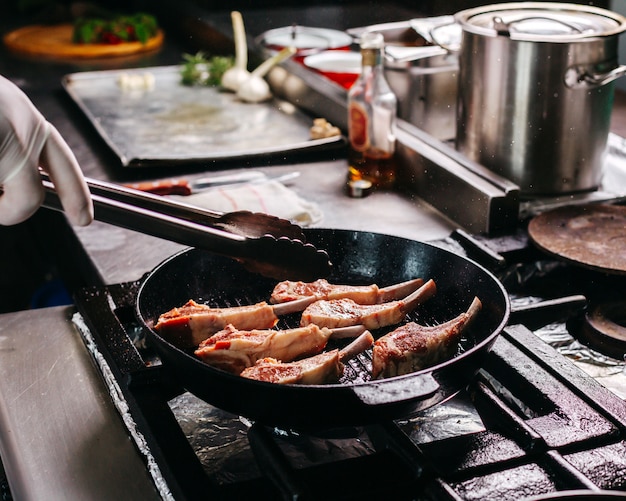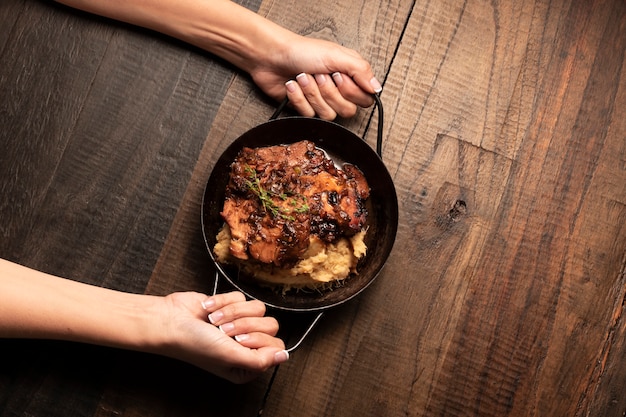Let's be honest, there's something undeniably satisfying about grilling a steak over an open flame. But let me tell you, a perfectly cooked stovetop steak is a revelation. It's all about mastering the heat, the technique, and understanding the nuances of your chosen cut. You can achieve restaurant-quality results right in your own kitchen, no fancy equipment required. Trust me, I've been a grill master for years, but the stovetop has become my secret weapon for steaks.
This isn't about just throwing a piece of meat in a pan and calling it a day. It's about transforming your steak into a culinary masterpiece. We're talking about a beautiful sear that creates a crispy crust, a juicy and tender interior, and a level of doneness that's absolute perfection. So, grab your favorite pan and let's embark on this culinary adventure together.
(Part 1) choosing the right cut - Your Foundation for Success

Understanding the Steak Landscape
Choosing the right cut is like selecting the right canvas for a masterpiece. You want something that can handle the heat, has a good amount of marbling for flavor and tenderness, and is thick enough to hold its shape during cooking. Let's dive into the world of steak cuts and find your perfect match.
My Go-To Cuts for Stovetop Steaks
Here are a few cuts that I always reach for when I'm cooking on the stovetop. They're tried and true, delivering delicious results every time:
- new york strip: This classic cut is a crowd-pleaser for a reason. It's thick, flavorful, and boasts a nice balance of fat. Look for a strip that's at least an inch thick for optimal results.
- Ribeye: Ah, the ribeye. A true king of the steak world. Its rich, buttery flavor and generous marbling make it irresistible. Again, aim for a thickness of at least an inch.
- Tenderloin (filet mignon): If you're looking for something truly special, tenderloin is the way to go. It's incredibly tender, but it can be a bit lean, so you'll want to keep a close eye on it during cooking to avoid overcooking.
- Top Sirloin: This is a fantastic option for those who are budget-conscious but don't want to compromise on flavor. Just be sure to cut it against the grain for a more tender bite.
Cuts to Avoid for Stovetop Cooking
Now, let's talk about some cuts that are better suited for other cooking methods:
- flank steak: This cut is usually thin and tough, perfect for grilling or marinating. It's not ideal for stovetop cooking because it can easily become dry and chewy.
- skirt steak: Similar to flank steak, skirt steak is a thin cut that's best suited for quick searing and slicing thin. It's delicious in tacos or other dishes but not ideal for a classic pan-seared steak.
(Part 2) Prepping for Success - Setting the Stage for Perfection

The Power of Rest: Bringing Your Steak to Room Temperature
This might sound like an unnecessary step, but resting your steak at room temperature for about 30 minutes before cooking is crucial. It allows the steak to come to a more uniform temperature, ensuring that it cooks evenly. Imagine this: you take a steak straight from the refrigerator, and the cold core makes it difficult to get a consistent sear and cook it to your desired doneness. But give it time to warm up, and you'll be rewarded with a more flavorful and evenly cooked steak.
Seasoning Like a Pro - A Simple Yet Essential Step
When it comes to seasoning, simplicity is key. Let the natural flavors of the steak shine through. I stick to the basics: salt and pepper. The salt draws out moisture and helps create that beautiful crispy crust. Pepper adds a bit of warmth and complexity. I always use freshly ground black pepper, but a good pre-ground mix will also do the trick.
Here's a tip: Don't be shy with the salt. I use about a teaspoon per side. The salt will create a delicious crust and enhance the steak's natural flavors. You can add additional spices if you like, like garlic powder, onion powder, or paprika, but always remember the importance of the salt and pepper.
(Part 3) Achieving That perfect sear - The Foundation of a Great Steak

Choosing the Right Pan: The Hero of Your culinary journey
You need a pan that can handle the high heat and distribute it evenly. My go-to is a cast iron pan. It heats up quickly, retains heat incredibly well, and creates an amazing sear. Plus, it's virtually indestructible. If you don't have a cast iron pan, a heavy-bottomed stainless steel pan will work well. Just make sure it's oven-safe if you plan to finish the steak in the oven.
Heating It Up - Getting Your Pan Ready for the Star
Now, it's time to turn up the heat. You want your pan scorching hot. For a cast iron pan, I usually start on medium-high heat and then increase it to high once the pan is preheated. You can check if it's hot enough by using a heatproof spatula or tongs. If you feel the heat radiating from the pan, you're good to go. You should see the oil shimmering, maybe even starting to smoke. Don't worry, that's a good sign!
The Art of the Sear: Creating that Irresistible Crust
Add a generous amount of oil to your hot pan. I prefer using a neutral oil with a high smoke point, like avocado oil or grapeseed oil. Once the oil is shimmering, carefully place your steak in the pan. Let it cook undisturbed for about 3-4 minutes per side. Resist the temptation to move it around. You want to let that crust develop. You'll hear a satisfying sizzle as the steak hits the pan. It's music to your ears.
Flipping and Finishing: Building on that Foundation
After those first 3-4 minutes, use tongs or a spatula to carefully flip the steak. Make sure to keep the pan hot. Let it cook for another 3-4 minutes on the second side. You can continue flipping the steak to sear all sides, or you can finish cooking it in the oven to get that perfect level of doneness.
(Part 4) Reaching the Desired Doneness - The Key to steak perfection
The internal temperature Game: Achieving Precision
Here's where a meat thermometer becomes your best friend. Especially for thicker cuts, it's essential for ensuring even cooking and reaching the desired level of doneness.
| Doneness | Internal Temperature (°F) | Internal Temperature (°C) |
|---|---|---|
| Rare | 125-130 | 52-54 |
| Medium-Rare | 130-135 | 54-57 |
| Medium | 135-140 | 57-60 |
| Medium-Well | 140-145 | 60-63 |
| Well-Done | 145-150 | 63-66 |
The "Finger Test" - A Rough Guide
If you don't have a meat thermometer, you can try the "finger test" as a rough guide. Press your finger into the fleshy part of your palm just below your thumb. That feeling is roughly the same as a rare steak. Now, press your thumb into the fleshy part of your palm just below your thumb. That feeling is roughly the same as a medium-rare steak. It's not as accurate as a meat thermometer, but it can give you a general idea.
Finishing in the Oven: Even Cooking for Thicker Cuts
Once your steak has a beautiful sear on all sides, you can transfer it to a preheated oven to finish cooking. I usually preheat the oven to 350°F (175°C). For medium-rare, cook it for another 5-7 minutes. This helps cook the steak evenly throughout while retaining its juiciness. Adjust the cooking time depending on the thickness of your steak and your desired doneness. But always, always use that meat thermometer to check the internal temperature.
(Part 5) Resting the Steak: The Secret to Juicy Tenderness
Resist the temptation to dive right into your steak after it's cooked. Let it rest for at least 5-10 minutes before slicing and serving. This allows the juices to redistribute throughout the steak, resulting in a more flavorful and tender experience. When you cut into a steak right off the pan, those delicious juices run out, leaving you with a dry and disappointing meal. Resting is crucial for locking in those juices and creating a steak that's truly melt-in-your-mouth delicious.
(Part 6) Mastering the Art of Slicing: A Final Touch of Elegance
After resting, it's time to slice your steak. This isn't just about cutting it into pieces, it's about showcasing the beautiful marbling and creating bite-sized pieces that are easy to chew. The key is to cut against the grain. The muscle fibers run in a specific direction, and cutting across those fibers helps break them down, resulting in a more tender steak.
(Part 7) Elevate Your Steak Game with Sauces - Adding a Finishing Touch
The Power of a Simple Sauce - Elevating Your Culinary Creation
A perfectly cooked steak can stand on its own, but a good sauce can take it to the next level. A classic red wine sauce or a simple compound butter can enhance the flavor and create a truly unforgettable dish. Let your creativity shine.
Creating a Simple Pan Sauce - Easy Elegance
A simple pan sauce is a classic for a reason. Deglaze the pan with a little red wine, chicken stock, or even just a splash of water. Scrape up all the delicious bits that have stuck to the bottom of the pan. Add some butter, herbs, and seasonings, and you've created a delicious sauce. It's quick, easy, and unbelievably delicious.
(Part 8) Serving Your Culinary Masterpiece - Presenting Your Steak with Pride
Presentation Matters: Creating a Visually Appealing Dish
Now that you've created a perfectly cooked steak, it's time to present it like the masterpiece it is. Serve it on a bed of creamy mashed potatoes, fluffy rice, or a vibrant salad. Keep the plate clean and simple, allowing the steak to take center stage.
A Touch of Elegance - The Power of Garnish
For a touch of elegance, I like to add a sprig of fresh rosemary or thyme. A simple garnish can elevate the look of your dish, making it look even more impressive.
(Part 9) FAQs - Answering Your Steak-Related Questions
1. What if my steak is too thick to cook all the way through on the stovetop?
That's where the oven comes in. Once you've seared your steak on all sides, transfer it to a preheated oven to finish cooking. This ensures even cooking throughout. Just remember to check the internal temperature with a meat thermometer.
2. Can I use any oil to sear my steak?
It's best to use a neutral oil with a high smoke point, such as avocado oil, grapeseed oil, or canola oil. These oils can withstand high heat without burning or releasing unpleasant flavors. Stay away from oils with low smoke points, like olive oil, as they will likely burn before your steak is cooked.
3. How do I know if my steak is done?
The best way to determine doneness is by using a meat thermometer. This is especially important for thicker cuts of steak. Alternatively, you can try the "finger test", though it's not as precise.
4. What if my steak is overcooked?
Don't worry, it happens to the best of us! If your steak is overcooked, it won't be as juicy and tender as it could be. However, it can still be delicious. To salvage it, you can slice it thinly and serve it in a sandwich or salad. The overcooked meat will be less noticeable in these dishes.
5. What if my steak is undercooked?
If your steak is undercooked, simply return it to the pan or oven for a few more minutes to cook it to your desired doneness. Just remember to check the internal temperature with a meat thermometer. Don't be afraid to adjust the cooking time as needed.
There you have it, my friends. The secrets to cooking the perfect stovetop steak are within your grasp. Now go forth and create a culinary masterpiece!
Everyone is watching

Corn on the Cob: The Ultimate Guide to Perfectly Cooked Ears
Healthy MealsAh, corn on the cob. Just the name evokes images of sunny days, barbecues, and that sweet, juicy flavour that ...

Perfect Pork Roast Oven Cooking Time: A Guide to Delicious Results
Healthy MealsThere's something truly satisfying about a perfectly roasted pork. The aroma alone is enough to make your mout...

Ham Cooking Time: How Long to Bake, Smoke, or Boil a Delicious Ham
Healthy MealsAh, ham. It's a classic, isn't it? A real crowd-pleaser, especially around holidays. And when done right, it'...

Scallops: The Ultimate Guide to Perfect Cooking
Healthy MealsAh, scallops. Those delicate, sweet, and utterly delicious morsels of the sea. They hold a special place in my...

Spaghetti Squash: The Ultimate Guide to Cooking and Serving
Healthy MealsRemember that time you saw spaghetti squash at the supermarket, looking all bumpy and strange, and thought, "W...
